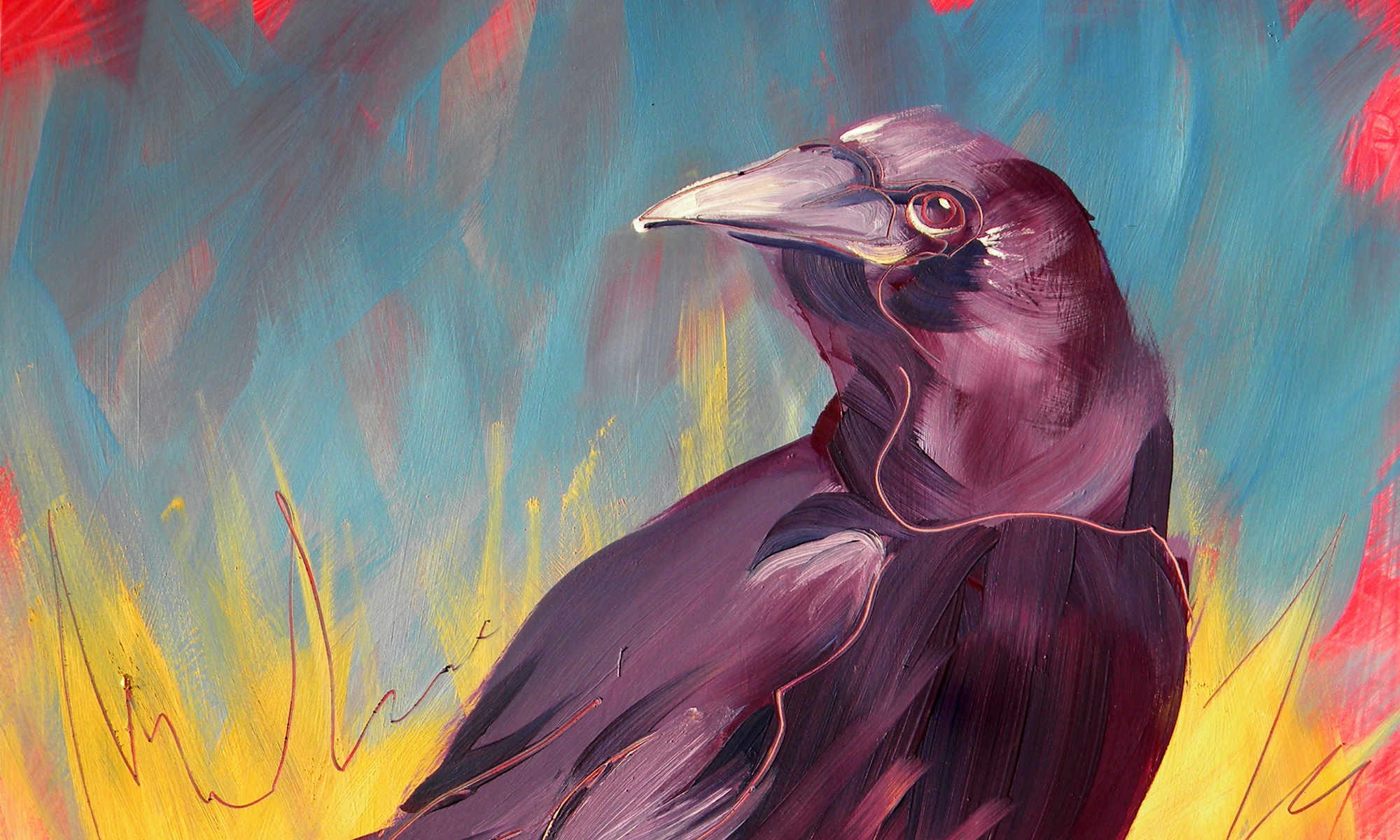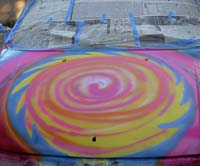 The Jackson Street Youth Shelter Art Car (van) is ready for the raffle. Buy raffle tickets to support the Shelter. Read all about the Art Car progress and the Shelter’s needs on their web site.
The Jackson Street Youth Shelter Art Car (van) is ready for the raffle. Buy raffle tickets to support the Shelter. Read all about the Art Car progress and the Shelter’s needs on their web site.
I’ve worked with the Jackson Street Youth Shelter between Summer 2006 and June 2007 to transform a Dodge Voyager van into an art car.
Introduction and Inspiration I was approached by the shelter’s director in the summer of 2006 to transform a donated van into an art car in the hopes of raffling it off to raise funds for the shelter. “Of course!” I said. It had been my plan to transform my motorhome into an art car, but hesitated due to my lack of experience. This van provided me a surface on which to experiment.
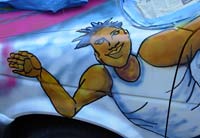 On my travels around the country in 2005-06, I met a women who shared photos of her art car, which she decorates with LED and florescent lights inside and out. I had not heard of cars as art, per se, but had seen many kinetic sculptures at da Vinci Days festival in Corvallis. The artist mentioned the Burning Man Festival and encouraged me to attend next year. The festival’s online gallery showcases both cars and kinetic sculptures.
On my travels around the country in 2005-06, I met a women who shared photos of her art car, which she decorates with LED and florescent lights inside and out. I had not heard of cars as art, per se, but had seen many kinetic sculptures at da Vinci Days festival in Corvallis. The artist mentioned the Burning Man Festival and encouraged me to attend next year. The festival’s online gallery showcases both cars and kinetic sculptures.
I am also inspired by BMW’s gallery of art cars painted by famous artists. My favorite is Esther Mahlangu’s 525i from 1991. I’ve always admired the Ndebele women’s home murals, and now there is one on a car!
For ongoing inspiration and how-to knowledge, I look to the Art Cars in Cyberspace site.
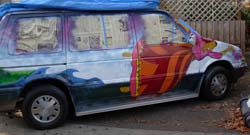 Process, tools, and techniques
Process, tools, and techniques
We held a few meetings with staff and residents of the shelter to inspire ideas and discuss logistics. A sheltered painting bay would have been ideal, but one did not became available until late November. Residents/staff agreed to sand and prime the van and leave the painting to me. I designed a simple scene with a man and women flying in the dawn above the sea and fields, with these words to be added at the end: “Let me breath and soar; just let me breath and soar.” [We left out the words due to space constraints.]
After 9 months the van painting is complete. Technical difficulties, my schedule, and the cold, rainy weather held up the progress but warm weather and new energy helped us get it done.
Masking, sanding, and spray priming was completed before I drew the design onto the van. The use of face masks is essential when sanding, as the tiny paint chips are bad for the lungs.
The pencil does show through thinner areas and may need a second coat. Though some artists do leave their under-drawing visible to add texture. I tend to like this effect, but am not sure how well it will be received on a car. 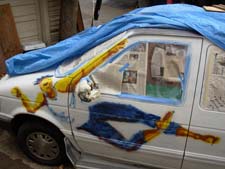 I purchased small hobby-sized enamel paint for the airbrush, along with a thinner and cleaner. These colors were rich and metallic and expensive. Next time I paint an art car, I will start with the larger, areas and work into the detail. Since I had not airbrushed anything important before, I decided to start with some detail…my first sprays of paint were to form the male figure.
I purchased small hobby-sized enamel paint for the airbrush, along with a thinner and cleaner. These colors were rich and metallic and expensive. Next time I paint an art car, I will start with the larger, areas and work into the detail. Since I had not airbrushed anything important before, I decided to start with some detail…my first sprays of paint were to form the male figure.
My airbrush did well enough and this practice area, I knew, would be spayed over again as I improved my touch, angle, and timing.
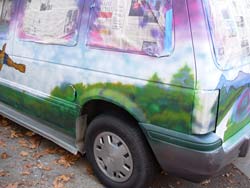
I’ve been using a Paasche double-action airbrush and compressor. The airbrush is difficult to clean but must be done well before any paint will come out of the tip. I do not enjoy this part of the process and often spend too much time fiddling with it. But once I get going, the painting is fast and fun. I have a tendency to want to spray like I paint…with a bit of spontenaity. I must mask off areas first, however, or risk wasting expensive paint and ruining decent work. To mask, I used mostly the blue painters masking tape, in a wide width. This can be supplemented with newspaper to help cover larger areas. Now, this is not the proper way to mask; most airbrush artists use masking film or stencil material and cut exactly with knives. I am too lazy and prefer quick tape jobs.
To define edges, I wrote around general and detail areas with black, orange, and blue Sharpie permanent markers. These areas seem to be permanent until I spray a clear coat on top, though. If I do not spray too close to the surface, the colors don’t run enough to matter. 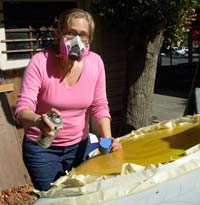 Much of the front has been resanded and may need to be cleaned with denatured alcohol to clean whatever is keeping paint from adhering. Not a great loss; the design was a bit flawed, so it’ll be ok to start again. One of the cans of white has caused problems with running; it takes all the underlying paint color off as it runs down over the detail work. Ugh. If I had marked that can or thrown it away, then
Much of the front has been resanded and may need to be cleaned with denatured alcohol to clean whatever is keeping paint from adhering. Not a great loss; the design was a bit flawed, so it’ll be ok to start again. One of the cans of white has caused problems with running; it takes all the underlying paint color off as it runs down over the detail work. Ugh. If I had marked that can or thrown it away, then
I wouldn’t have done this twice. We purchased a higher-quality, more opaque paint and it worked! It covered the flaws with a much more opaque layer.
Conclusion
It is a worthwhile endeavor and I’ll probably do it again. Murals, whether on cars or on walls, are a big commitment and weigh on my mind when I cannot be working on them. Practice is important, along with improving my knowledge of the tools, surfaces, and media to work with. I plan on buying only the best paint next time, which will save time and cover the surface better.
Because of time constraints, the next art car must be done with more help. I enlisted my daughter to help draw detail on the skirt of the women flying. And I enlisted sanding and priming from the director and her staff. But I envision a project where many are painting at one time. Will I be able to work with more activity going on? Will others? I’m interested in trying it!
